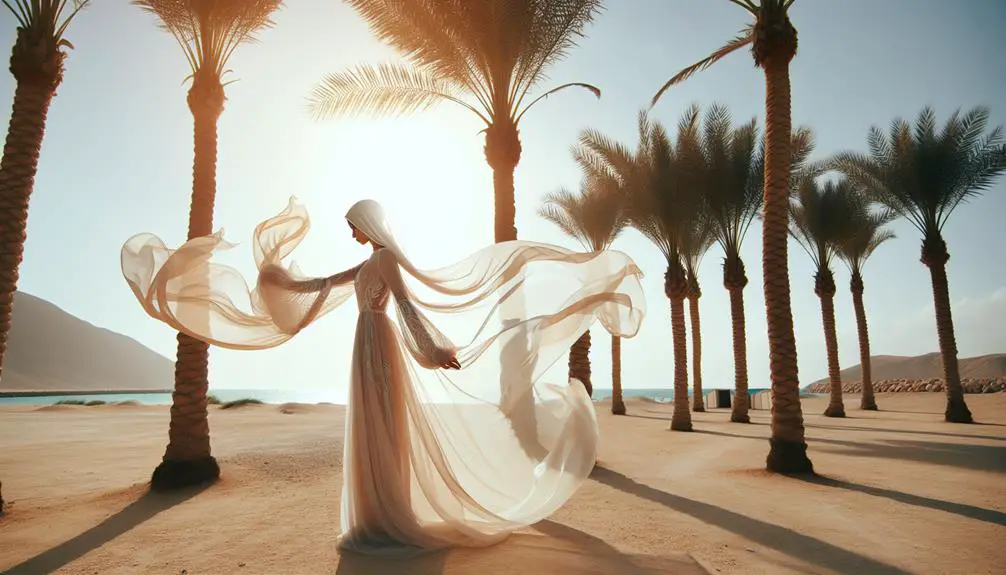Yeah, chiffon is definitely cool in hot weather. It's super light and airy, which lets the breeze flow right through. Plus, it's made of materials like silk, cotton, or synthetics, which help it breathe really well. I particularly appreciate its sheer texture and thinness because that's what helps keep you cool when it gets really hot out. It also dries fast, so even if you do sweat a bit, it won't cling to your skin for long. And if you're worried about style, chiffon always looks effortlessly chic. Stick with me, and I'll show you why it's perfect for a variety of hot-weather occasions.
Table of Contents
Key Takeaways
- Chiffon's lightweight and airy nature enhances breathability, keeping you cool in hot weather.
- The fabric's loose weave allows for excellent air circulation, preventing skin from feeling sticky.
- Chiffon dries quickly, reducing discomfort from sweat in high temperatures.
- Its sheer texture and thin composition help in maintaining a lower body temperature.
- Despite its breathability, chiffon offers low UV protection, necessitating additional sun protection measures.
Understanding Chiffon Fabric
Chiffon is a light, airy fabric that's perfect for staying cool on a hot day. When you're looking to beat the heat, wearing a chiffon dress or blouse is like having a personal breeze wherever you go. It's all about the material's unique qualities. Chiffon is made from silk, cotton, or synthetic fibers, which gives it a beautiful, flowing appearance. But it's not just about looks; this fabric excels in breathability and lightness, making it a top choice for summer wear.
Now, let's dive a bit deeper into why chiffon feels so dreamy on your skin. Its sheer texture comes from a slightly puckered effect, which happens due to the twists in the yarns during weaving. This creates small pockets of air within the fabric, enhancing its ability to offer a cooling sensation as you move. Plus, chiffon's thinness allows for excellent air circulation, helping your body regulate its temperature in sweltering conditions.
Chiffon Vs. Other Summer Fabrics
When comparing chiffon to other summer fabrics, it's clear that its breathability and lightweight nature set it apart. I've found that while cotton and linen are also great for summer, chiffon has a unique edge. It's not just light; it feels almost airy, making it a top choice for those really hot days.
Take linen, for example. It's breathable, sure, but it tends to be a bit heavier and doesn't drape quite as nicely as chiffon. And while cotton is a classic go-to for beating the heat, it doesn't always allow for the same flowy, elegant movements that chiffon can offer. There's something about the way chiffon floats and flutters that feels just right when you're trying to stay cool and stylish.
Now, let's talk about synthetic fabrics like polyester. They're often lightweight, but they just can't match chiffon's natural ability to let air pass through. I've worn polyester on hot days and ended up feeling more trapped and sweaty than refreshed.
Moisture Management in Chiffon
When it's sweltering outside, I'm always curious about how different fabrics handle sweat. Chiffon's not only light, but it also dries quickly, making it a solid choice for staying comfy and dry.
Let's explore how well chiffon manages moisture, from its absorption properties to its breathability.
Chiffon Absorption Properties
Regarding moisture management, chiffon doesn't absorb sweat as well as other fabrics.
When you're considering what to wear on a hot day, you might think chiffon's light and airy feel is the way to go, but here's the scoop: chiffon isn't your best bet if you're aiming to stay dry.
Since it's typically made from silk or synthetic materials like polyester, chiffon tends to let moisture sit on your skin rather than wicking it away.
This can lead to a sticky, uncomfortable feeling, especially if you're outdoors for a long period or moving around a lot.
Breathability and Comfort
Chiffon's breathability makes it a popular choice for staying cool, despite its moisture management challenges. While chiffon isn't the best at wicking away sweat like some other fabrics, it still has its perks.
Here's how you can make the most of chiffon's qualities, even if it's not a moisture-wicking champ:
- Layer Smartly: Pair chiffon with breathable undergarments to enhance comfort, ensuring that sweat has a way to escape.
- Choose Lighter Colors: Lighter shades reflect sunlight better, reducing the amount of heat absorbed and helping keep you cooler.
- Stay Breezy: Opt for looser fits in chiffon to maximize air circulation around your body, aiding in natural cooling and comfort.
Quick Drying Capabilities
While chiffon may not be the best at wicking away moisture, it does offer surprisingly quick drying capabilities. Let's say you get caught in a summer rain shower, or you're sweating a bit after a brisk walk. Chiffon's light and airy weave means it won't cling to your skin, and it dries faster than you'd think. Here's a quick comparison to give you a clearer picture:
| Fabric | Drying Speed | Comfort Level |
|---|---|---|
| Chiffon | Fast | High |
| Cotton | Moderate | Moderate |
| Denim | Slow | Low |
| Wool | Very Slow | Low |
Breathability Features of Chiffon
One key feature of chiffon that makes it a go-to fabric in warm weather is its remarkable breathability. This isn't just a fancy term tossed around; it's what keeps you feeling cool and fresh, even when the sun's blazing down. Here's why chiffon's breathability really stands out:
- Lightweight Nature: Chiffon is incredibly light. This isn't just great because it feels like you're wearing almost nothing. It also means that air passes through the fabric much more easily than through heavier materials. You'll literally feel the breeze as if you weren't wearing anything at all.
- Loose Weave: The weave of chiffon fabric isn't as tight as others. This loose weave allows for a better air flow, which significantly aids in ventilation and cooling. It's like having a natural air conditioner built into your outfit.
- Moisture Absorption: Chiffon does a pretty decent job at absorbing sweat from your skin. This means that it pulls away moisture, allowing it to evaporate quickly and leaving you dry and comfortable faster than many other fabrics would.
UV Protection and Chiffon
Now, let's talk about how chiffon stacks up when it comes to UV protection.
It's not just about staying cool; it's also about keeping your skin safe from the sun.
We'll look at chiffon's natural UV resistance and ways to boost that protection even further.
Chiffon UV Resistance
Considering its lightweight nature, chiffon doesn't offer much UV protection. This might come as a surprise because it's such a popular fabric for sunny days. But here's the deal:
- Fabric Thickness: Chiffon's sheer and thin quality means less barrier against the sun's rays. Thicker fabrics generally provide better UV defense.
- Weave Density: The loose weave of chiffon allows more UV light to pass through compared to denser weaves found in other materials.
- Material Composition: Chiffon is often made from silk or synthetic fibers like polyester, which aren't inherently UV resistant unless treated or blended with other protective fibers.
Enhancing Chiffon's Protection
While chiffon isn't naturally strong in UV protection, there are effective ways to boost its shielding capabilities. You can start by choosing chiffon treated with UV-blocking chemicals. Many manufacturers now offer fabrics that've been specially coated to enhance their resistance to sun damage. It's a simple yet powerful way to upgrade your summer wardrobe.
Another option is to wear a sunscreen underneath your chiffon clothing. It might sound odd, but it's super effective. Just apply a good layer of broad-spectrum sunscreen on your skin before you throw on that airy chiffon blouse. This way, even if the fabric itself isn't the best at blocking UV rays, you're still covered. Literally! So, don't shy away from chiffon in hot weather; just prep a bit.
Styles and Types of Chiffon
Chiffon comes in various styles and types, each offering a unique blend of elegance and breathability. As I've explored different types of chiffon, I've noticed that they're not just for fancy occasions—they're versatile enough for everyday wear too! Let me break down a few popular types so you can choose the right one for your needs.
- Silk Chiffon
This is the most luxurious type. It's super lightweight and has a slightly rough feel, but don't let that fool you—it drapes beautifully and feels soft against the skin. Perfect for those elegant evening dresses.
- Polyester Chiffon
More affordable and durable than silk, polyester chiffon is also lightweight and has a smoother texture. It's great for casual blouses and dresses that you can rock on a sunny day without breaking the bank.
- Cotton Chiffon
A bit less common, but it's gaining popularity for its breathability and softness, making it ideal for summer wear. It combines the lightness of traditional chiffon with the comfort of cotton.
Each type has its charm and function, ensuring you stay cool and chic no matter the temperature. Whether you're dressing up or keeping it casual, there's a chiffon just for you!
Durability of Chiffon Garments
So, let's talk about how tough chiffon really is.
I'll give you the scoop on how to take care of it and share some tips to make sure it lasts longer.
You'd be surprised how a little care can go a long way with this delicate fabric!
Chiffon Fabric Strength
I've found that despite its delicate appearance, chiffon holds up pretty well over time. You might think that something so light and airy could easily tear or wear out, but it's surprisingly resilient if handled correctly. Here's why:
- Weave Structure: Chiffon's unique weave gives it a bit of a stretch, allowing it to resist tears unlike more rigid fabrics that might rip under stress.
- Silk vs Synthetic: Silk chiffon is generally more durable than synthetic versions, though both hold up decently with proper care.
- Layering Effect: Often, chiffon garments are designed with multiple layers, which not only creates that beautiful flow but also adds to the overall strength of the garment.
Care Instructions
To keep your chiffon garments looking great, it's crucial to follow a few simple care instructions. First, always check the label. Most chiffon items need to be hand washed or dry cleaned—never just throw them in the washing machine with everything else. The fabric is delicate, and rough treatment can lead to tears.
When hand washing, use cold water and a mild detergent. Gently swish the garment around; don't wring it out. Instead, lay it flat on a towel, roll the towel up and press out the excess water. Air drying is the way to go.
Also, be careful with the iron. Use a low heat setting and place a cloth between the iron and the chiffon.
Longevity Tips
Chiffon's delicate nature means you'll need a few tricks up your sleeve to keep it looking sharp for years. Here's how I make sure my chiffon pieces last:
- Wash Wisely: Always hand wash or use a gentle cycle with cool water. Harsh agitation from regular cycles can tear the delicate fabric.
- Dry Delicately: Skip the dryer! Lay it flat or hang to dry. Heat can ruin the fibers and hanging wet chiffon might stretch it out.
- Store Carefully: Never fold chiffon tightly. Instead, hang it or loosely roll it to avoid wrinkles and creases.
Following these simple tips, you'll keep your chiffon looking fresh and fabulous, wear after wear!
Chiffon in Various Climates
Adapting to different climates, chiffon remains a preferred choice for its breathability and lightness. I've worn chiffon in a variety of settings, from hot, humid beaches to cooler, breezy evenings, and it's always worked out well. In tropical climates, chiffon's airy feel keeps me from feeling like I'm wrapped up in a sauna suit. The fabric doesn't cling to my skin, which is a huge plus when it's super hot and sticky outside.
In dryer, temperate areas, chiffon still holds up pretty well. I just layer it up a bit. A chiffon blouse under a sweater or a jacket works great for those cooler days. It's versatile like that. Even in spring, when it can get a bit windy, chiffon doesn't disappoint. It's light enough to not feel bulky but still offers that elegant flow that looks amazing even in a light breeze.
Care Tips for Chiffon
While it's great that chiffon works well in various climates, let's focus on how to keep it looking its best. Chiffon's delicate nature means it needs a bit more TLC than some other fabrics, but don't worry, it's not rocket science! Here are three straightforward tips to ensure your chiffon stays fabulous:
- Washing Carefully:
Avoid tossing your chiffon garments into the washing machine with everything else. They prefer a gentle hand wash in cold water. Use a mild detergent and don't wring it out; instead, gently squeeze the excess water. This keeps the fibers intact and prevents any shape distortion.
- Drying and Ironing:
Always air dry chiffon by laying it flat on a towel. This avoids stretching the fabric. If you need to iron, set it to the lowest heat and use a pressing cloth between the iron and the chiffon. Direct heat can cause damage, so be patient and gentle.
- Storing Properly:
Store chiffon garments hanging if possible. Use padded hangers to prevent creases and maintain shape. Avoid overcrowding your closet to prevent snagging and ensure your chiffon doesn't get crushed.
Following these tips will keep your chiffon looking elegant and pristine, ready for any occasion!
Chiffon for Different Occasions
Chiffon dresses up and down brilliantly, making it perfect for weddings, work, and weekend outings. Let me tell you, there's nothing like a chiffon dress to make you feel right for any occasion.
For weddings, a flowy chiffon gown in a soft pastel shade can make you look like a dream without overpowering the bride. It's all about that elegant, floaty vibe that dances as you move.
At work, a chiffon blouse pairs beautifully with a sharp blazer and tailored pants. It's lightweight enough to keep you cool under pressure but still looks polished and professional. I've gotten tons of compliments on days I wear chiffon—it just adds that touch of softness to a strict office outfit.
And for those lazy weekend brunches or outings with friends, a chiffon top with jeans is my go-to. It's comfy but looks put together, and it handles the summer heat like a champ. Plus, if the day turns into night, I'm still set for dinner or a casual drink out. Chiffon's versatility really shines through, making it a staple in my wardrobe for practically any event. It's a master at adapting, just like we need to be!
Environmental Impact of Chiffon
The environmental impact of producing and using this fabric is pretty significant, and it's something we should all be aware of. Chiffon, especially when made from synthetic materials like polyester, can be tough on our planet. Here's why:
- Resource Intensive Production: Producing polyester chiffon requires a lot of petroleum, a non-renewable resource. This process isn't only resource-intensive but also releases a lot of CO2, contributing to global warming.
- Water Pollution: The dyeing process for chiffon can be quite dirty. It often involves toxic dyes and chemicals that end up in our water systems. This not only harms aquatic life but can also affect the drinking water in surrounding communities.
- Longevity and Waste: Polyester chiffon isn't the most durable. It can tear easily and doesn't decompose quickly in landfills. This means it hangs around for a long time, contributing to the ever-growing issue of textile waste.
It's clear that the impact of chiffon, particularly synthetic varieties, is more significant than many might think. As we continue to use and produce this fabric, it's crucial to consider these environmental consequences.
Alternatives to Chiffon for Heat
Considering the environmental toll of chiffon, let's explore some cooler, eco-friendlier alternatives perfect for hot weather. When you're trying to beat the heat but still want to stay stylish, it's essential to choose the right materials. Not only do they need to be lightweight and breathable, but it's also great if they're kinder to our planet.
Here's a quick rundown of some top choices:
| Material | Benefits |
|---|---|
| Linen | Highly breathable and absorbs moisture well, making it super comfy during hot days. |
| Hemp | Durable and has a good breathability; grows quickly and requires less water and pesticides. |
| Bamboo | Soft, cooling, and has natural antibacterial properties, plus it's biodegradable. |
| Tencel | Made from wood pulp, it's soft, breathable, and less energy-intensive to produce than other fabrics. |
Each of these fabrics brings something unique to the table. Linen, for instance, isn't just cool; it also gives off a laid-back vibe that's perfect for summer wardrobes. Hemp, aside from its environmental benefits, has a rustic look that can add character to your outfits. Bamboo feels luxurious against the skin, while Tencel offers a sleek, smooth finish that drapes beautifully. So next time you're shopping, maybe skip the chiffon and give these a try!
Frequently Asked Questions
Can Chiffon Be Recycled or Upcycled Effectively?
Like turning old jeans into trendy tote bags, I've found chiffon can be both recycled and upcycled effectively, making it great for creative reuse in fashionable and eco-friendly projects.
How Does Chiffon React to Static Electricity?
Chiffon tends to cling due to static, which can be super annoying. I've found that using a dryer sheet or spraying a bit of anti-static spray really helps to keep it manageable.
Are There Hypoallergenic Properties in Chiffon?
I've never noticed any hypoallergenic claims about chiffon. It's like expecting a delicate flower to be a shield against pollen. However, its synthetic make-up means it isn't naturally hypoallergenic.
What Historical Periods Prominently Featured Chiffon?
I've found that chiffon was huge in the 1920s and 1930s, especially in flapper dresses and evening wear. It made a big comeback with 1960s fashion too, thanks to its light, flowy nature.
Can Chiffon Be Used for Winter Garments?
Chiffon's typically seen as a summer fabric, but it can definitely be layered for winter wear. I'd recommend pairing it with warmer materials like wool or using it for stylish, breathable lining.
- How Does Ring Spun Cotton Affect Garment Fit and Shape Retention? - August 13, 2024
- What Are the Challenges in Producing Ring Spun Cotton? - August 13, 2024
- Is Ring Spun Cotton Suitable for Plus-Size Clothing? - August 13, 2024







